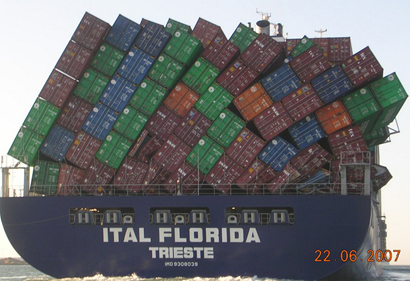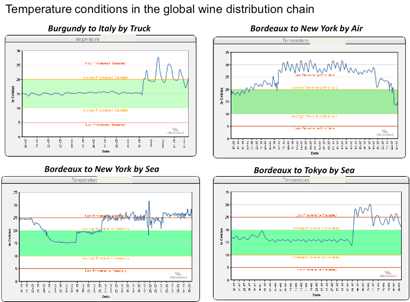What’s greater: “cooked,” “corked” or counterfeit wines? Some evidence

Heat damage might be the biggest silent killer in the wine industry–more even than corked wine, which has much greater renown.
In our recent discussion on “cooked” wine, Louise from eProvenance joined the discussion. Founded by Eric Vogt, a wine collector formerly of Boston Consulting Group, eProvenance can provide a detailed history of wine’s temperature during transit via an RFID tag inserted into either a case or tacked on to a pallet of wine.
Tracking 1,450 shipments in and between the Northern and Southern hemispheres, they assembled a fascinating report: eProvenance found that almost 10 percent of shipments were exposed to temperatures of 30 degrees celsius (86 degrees Fahrenheit) or more for 18 hours or more, a threshold ETS Labs found as significant a perceptible damage in wine. The report generously does not declare all that wine to be “cooked,” instead saying it is merely “at risk”; they suggest 2.8 percent of shipments as having perceptible damage.
Interestingly, some of the highest heat exposure comes not from the journey in the refrigerated container but rather the first and last miles of the journey, as the wine gets to and from the loading bays of wineries and shops. They estimate the monetary value of “at risk” wine to be about $9 billion and the heat-damaged wines to be worth about $2.5 billion.
While eProvenance clearly has an innovative technology to sell and thus may overstate the size of the problem, I am willing to go out on a limb and say that the quantity of heat-damaged wines represents a greater problem for wineries and consumers than counterfeiting. While the Jefferson bottles and their ilk may pose problems for the pinnacle of the wine world, heat-damage may be much farther reaching, especially as cheaper, high-volume wines are less likely to benefit from temperature control.
Heat damage, with its diminution of wine’s aromas and freshness that leads to bad consumer experiences, could well be on par with or a greater problem than TCA, or “corked” wines. If I were a vintner, I would strongly consider adding temperature tracking to every delivery and take corrective measures if problems arose in the supply chain. As a consumer, I’d welcome heat shipping data or a third-party certification on each bottle. But then again, I like data–almost as much as I like sipping a glass of wine that isn’t flawed.





On July 25th, 2011 at 6:18 pm ,Lee wrote:
I always wondered if this is the case with South African wines, some seem inconsistent even within vintages. Maybe the problem is in the handling.
On July 25th, 2011 at 10:48 pm ,Laurie wrote:
I am never disappointed when a winery is reluctant to ship during hot seasons… in fact I tend to consider it a sign of love and respect for their wines and the decision gives them an edge,(in my estimation), over the wineries that don’t appear to worry about heat exposure.
On July 25th, 2011 at 11:16 pm ,Joe Jensen wrote:
Just posted a link to this with the comment below on my Facebook page!
Love to hear some others thought here!
Joe Jensen Jr on Facebook!
“As someone who is about to start importing wines, I am amazed when I hear from other established distributors and importers that they will compromise their wines to save a few dollars a case in shipping costs. The more I read on the problem the more I confirm my choice to pay the extra cost to ensure that my wines make it to Chicago in as close to the condition that they left the winery in!”
On July 26th, 2011 at 11:29 am ,Robin C wrote:
I know our Fed-Ex person has our few bottles that we order from out of state riding around in the truck for quite a while, and if we’re not there to receive the bottles they go to the warehouse for 24 hours or so. We don’t order in the summer; it would be hard not to buy wine from the wine stores in the summer – one more problem to mull over.
On July 26th, 2011 at 12:05 pm ,ted judd wrote:
i have no expectation of receiving a palatable wine after it sat overnight on the loading dock and was then transported during the heat of the day in brown, open sided, trucks with no air conditioning.
On July 26th, 2011 at 12:08 pm ,ted judd wrote:
you could also add “bottle shock” to the maladies of transportation. i cannot imagine the stress to which the wine is subjected in a container on-board a cargo ship during a summer squall.
On July 26th, 2011 at 2:11 pm ,Terrence Jones wrote:
Living in Malaysia for four years taught me very quickly what cooked wine tastes like.
The importers there know very well how the last mile can kill wine as it sits on the dock waiting to be warehoused. Furthermore, retail conditions often further exacerbated the issue with the air conditioners being turned off at night.
It’s often said that wine is more “hearty” than most people think – I’m glad to see some research being done into this real issue.
On July 26th, 2011 at 9:16 pm ,David Boyer wrote:
Cooked is certainly going to affect more consumers than corked or counterfeit wine from a numbers standpoint. Over 300 million cases of wine were sold in the US last year, and of that, over 90% was sold at retail for under $25 per bottle. Who gets the brunt of cooked wine ?Consumers buying lower end wine.
Any collector worth her/his salt will insist on shipping in appropriate weather conditions or have it held until they can ship safely so this segment is probably least affected because they also pay attention to provenance, plus serious collectors buy from reputable merchants. But this segment is affected more by corked wines because many of us open mature wines that used corks that came from an era of more TCA problems.
If you’re buying Château Pétrus in Las Vegas, you’re just asking for counterfeit wine but again, by the numbers, few will be affected by this accept for a handful of high-rollers. A few years ago I bought another case of older Château Cos d’Estournel from a source online, which to me was a great value, and a great wine. The bottles arrived with their familiar brick-colored labels but the vintage (1988) looked as though it was printed on the labels, in black ink no less, with a laser printer. I immediately called the retailer to inquire about this anomaly and the retailer seemed genuinely alarmed. All the while I’m thinking who in the world would counterfeit Cos at a $100 or so per bottle? Stranger things have happened in counterfeiting I suppose.
The retailer (who readily agreed to return my money and have me send the wine back, no questions) called the château and they verified that they would sometimes ship from their cellar, and they didn’t have labels for all vintages, so they printed them with the correct label and shipped them out. Up to the point that I actually put the wine in my mouth it was all intrigue, but when I actually tasted it, I knew it was exactly Cos because I had had a case before this one. Counterfeiting happens and I think those at the greatest risk are those buying trophy wines that are ‘too good of a deal’. As many have said before me: caveat emptor!
So in my experience: cooked, corked, counterfeit in that order.
David Boyer
classof1855.com
On July 27th, 2011 at 9:53 am ,Jack Bulkin wrote:
I opened a 96 Dalla Valle Cabernet last night that I purchased twelve years ago. It has been lovingly stored at 55 degrees in my cellar despite 100 degree temperatures where I live for five months every year.
The bottle was cooked. It is very disappointing and really is a distraction to fine wine collecting.
I don’t buy wines that would likely be counterfeited, but sadly we all buy wines that could be corked or heat damaged.
On August 7th, 2011 at 1:56 pm ,Jamie Goode wrote:
Most wine isn’t shipped in reefers. It’s worse than the picture you have outlined.
On August 20th, 2011 at 11:42 pm ,Donn Rutkoff wrote:
I might take the other side on how long it takes at 90 degrees. Two years ago, we had a heat wave in S Diego, and I had most, but not all, of my wine, under temp. control. I opened a few of the botles that were in 90+ heat for 4-5 days, and found no damage. But, don’t know what about 2 or 3 yrs later what might happen. Of course, not to recommend baking. But, for just a short while, wine might be sturdier than we think. Any input welcome.
On June 22nd, 2012 at 8:01 am ,Terroirist: A Daily Wine Blog » Daily Wine News: Das Kapital wrote:
[…] Colman suggests that “heat damage might be the biggest silent killer in the wine industry — more even […]